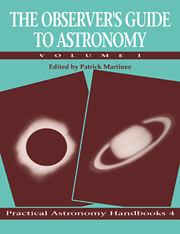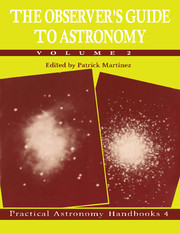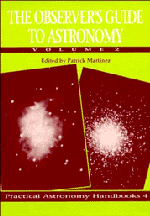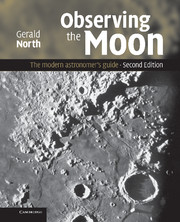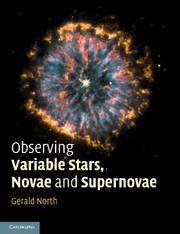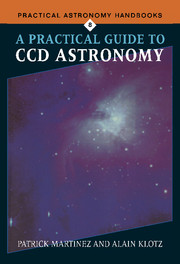The Observer's Guide to Astronomy
How can you find new minor planets, comets and novae? How can you use photoelectric detectors to derive the temperatures of stars? And how can you predict future eclipses and occultations of stars by minor planets? The questions asked by serious amateur astronomers are answered in this authoritative and wide-ranging guide. For each topic, sound practical methods of observation and the scientific background are given to lead you to better observations. Guidelines also show you how to record and catalogue your observations using the recognised professional terminology and classification schemes. From the simplest pencil drawings of the moon to observations of the most distant galaxies with state-of-the-art CCD cameras and photoelectric photometers, this guide is packed with practical tips for all types of amateur observations. It will develop the observational skills of the keen novice and satisfy the more demanding needs of the experienced amateur astronomer.
- Packed with practical tips on all methods of amateur observations of all types of astronomical objects
- Gives you the background theory to develop your scientific understanding and improve your observational skills
- Shows you how to record your observations using the professional classification schemes
Reviews & endorsements
'Quite frankly, you will not find a better guide to serious observational astronomy.' Astronomy Now
'These two volumes, together, constitute amazingly good observational guides for the serious amateur astronomer.' Spaceflight
'Not only are the practical methods of observation dealt with in great detail but the scientific background is also stressed. The aim is to train astronomers to make better and better observations, and to guide them towards the correct analysis of these observations and to the most useful way of presenting the data. The emphasis is on the development of good observational and analytical skills.' David Hughes, Nature
' … a comprehensive guide book which is highly recommmended to all serious amateurs.' Alan W. Heath, Journal of the BAA
'This is a gem of a book … it is a grand smorgasbord of material for the advanced amateur astronomer … Each of the ten chapters is meant to stand alone as an independent unit … this way the reader does not have to digest the entire book in order to get to what he/she needs to observe … The book is quite irresistible … well written, well organised and nicely cross-referenced … I highly recommend this book to any serious observer. It was worth the pain of writing a review just to get my hands on a copy of it!' Journal of the Royal Astronomical Society of Canada
'Altogether this is an outstanding work and no amateur with any pretensions to being active, nor any student astronomer, should be without a copy in their library.' The Observatory
Product details
September 1994Paperback
9780521379458
612 pages
246 × 172 × 29 mm
1.3kg
285 b/w illus. 4 maps 35 tables
Available
Table of Contents
- Volume 1: Contents (Volumes 1 & 2)
- The contributors
- Summary (Volumes 1 & 2)
- Preface
- Translator's preface
- 1. The Sun
- 2. Observing the Sun with a coronograph
- 3. Solar eclipses
- 4. The Moon
- 5. Planetary surfaces
- 6. Planetary satellites
- 7. The minor planets
- 8. Comets
- 9. Occultations
- 10. Artificial satellites
- Notes, references and bibliography - Volume 1
- Volume 2: Contents (Volumes 1 & 2)
- The contributors
- Summary (Volumes 1 & 2)
- 11. Aurorae
- 12. Meteors
- 13. Double and multiple stars
- 14. Variable stars
- 15. Deep sky novae and supernovae
- 16. Plate comparisons
- 17. Astrometry
- 18. Spectroscopy
- 19. Photoelectric photometry
- 20. Image-intensifiers and CCDs
- Appendices:
- 1. Time scales
- 2. The T60 Association
- Notes, references and bibliography - Volume 2.

